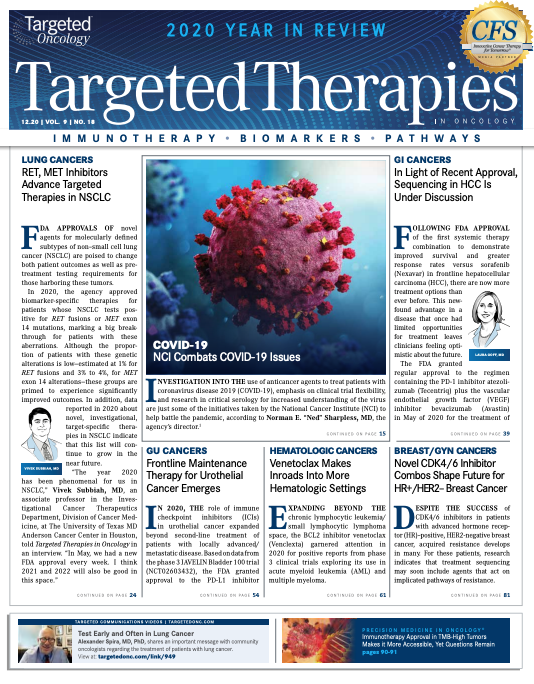Immunotherapy Approval in TMB-High Tumors Makes it More Accessible, Yet Questions Remain
Although the use of TMB as a biomarker has been established in certain tumors, such as non–small cell lung cancer, the pan-cancer approval came as a surprise to some in the oncology community.

This past June, pembrolizumab (Keytruda) monotherapy received accelerated approval for the treatment of solid tumors with a high tumor mutational burden (TMB) on the basis of results in 10 cohorts of previously treated patients in the KEYNOTE-158 trial (NCT02628067).1,2 Simultaneously, the FDA approved Foundation Medicine’s FoundationOne CDx assay as a companion diagnostic for pembrolizumab.1
Adult or pediatric patients whose tumors have a high TMB, defined as 10 or more mutations per megabase as determined by an FDA-approved test, can be treated with pembrolizumab after disease progression following prior treatment and if they have no satisfactory alternative treatment options.1,2
Although the use of TMB as a biomarker has been established in certain tumors, such as non–small cell lung cancer (NSCLC), the pan-cancer approval came as a surprise to some in the oncology community. “At Memorial Sloan Kettering [Cancer Center], we were surprised that the approval was given to all tumor types and not only for the 10 tumor types that were included in the KEYNOTE[-158] trial,” said Benoît Rousseau, MD, PhD, of the Department of Medicine, Division of Solid Tumor Oncology at Memorial Sloan Kettering Cancer Center in New York in an interview with Targeted Therapies in Oncology.
TMB Clarifies ICI Use in Solid Tumors
The lack of response to immune checkpoint inhibitors (ICIs) or development of resistance in certain patients has prompted a search for predictive biomarkers, with TMB emerging as one of the most promising.3,4
TMB varies among cancers and can range from 0.01 to greater than 1000 somatic mutations per megabase of interrogated genomic space.3,5 Some of these mutations result in neoantigens that enhance immune-mediated responses to the tumors that express them.3,5 Melanoma and NSCLC have historically demonstrated higher levels of TMB, whereas breast, kidney, and ovarian cancers typically have low expression.
TMB can also be highly variable within a given tumor type.6 For example, lung, head, and neck cancers typically have less variable TMB, whereas colon, bladder, and uterine cancers have more variable TMB.3
TMB-high tumors that have demonstrated a strong response to ICIs in clinical trials include cancer with related mutagenic effects, such as etiologic tobacco smoke in NSCLC and ultraviolet light in melanoma. However, outliers have suggested that this association is more correlative than causative, made evident by the activity observed in renal cell carcinoma and Merkel cell carcinoma, where ICI responses were better than what the TMB status would have predicted.3
Issues surrounding TMB as a biomarker in NSCLC therapy have persisted because of its unproven predictive value for overall survival (OS). The variability of TMB as a predictive marker has stood in contrast to other markers that are considered reliable indicators of improved OS in NSCLC, such as microsatellite instability (MSI), which itself contributes to TMB, PD-L1.5,6
Other issues concerning the tumor agnostic use of TMB include the assignment of equal weight to all mutations, although not all will result in immunogenic neoantigens; lack of a standardized TMB threshold; variability in assessment and interpretation; long test turnaround time; and failure rate due to inadequate sample quality or quantity.5-7
A recent study concluded that TMB may at best be a limited surrogate marker for response to immunotherapy. Although it may be considered a “reasonable” predictive biomarker in NSCLC, its predictive value in melanoma is weak, and it is not predictive in isolation for renal cell carcinoma.7 As such, some investigators have concluded that TMB may be more valuable as a single variable in a combination of predictive markers than as a reliable stand-alone biomarker for response to ICI.4
KEYNOTE-158 Trial Results KEYNOTE-158 is an ongoing, open-label phase 2 trial of pembrolizumab monotherapy in multiple types of advanced (unresectable and/or metastatic) solid tumors that progressed on standard-of-care therapy. The primary end point of the trial is the objective response rate; secondary outcomes include duration of response (DOR), progression-free survival (PFS), and OS.
In the treatment arm that supported the drug’s approval, patients received 200 mg of intravenous (IV) pembrolizumab on day 1 of each 3-week cycle for up to 2 years of therapy. In a separate arm, patients could receive IV pembrolizumab at 400 mg every 6 weeks for up to 2 years.
All eligible patients must have progressed following 1 or more lines of prior therapy, except individuals with colorectal cancer (CRC) who must have experienced treatment failure after a minimum of 2 lines of standard systemic therapy. Patients with melanoma or NSCLC were excluded.
A prespecified, prospective, exploratory biomarker analysis of the trial looked at the association of high TMB in tissue with outcomes in 10 tumor type–specific cohorts: anal, biliary, cervical, endometrial, mesothelioma, neuroendocrine, salivary, small cell lung, thyroid, and vulvar cancers. Investigators reported efficacy in patients who had at least 1 dose of pembrolizumab and evaluable TMB status. Of 1066 patients who received the PD-1 inhibitor as of the data cutoff, 105 of 805 patients with evaluable TMB were considered to be high expressors and comprised the safety population. Of 1050 patients enrolled at least 26 weeks before data cutoff, 790 patients with evaluable TMB were included in the efficacy population.8
At a median follow-up of 37.1 months, investigators observed an objective response in 30 of 102 patients (29%) in the TMB-high group versus only 43 of 688 (6%) in the non–TMB-high group. Four patients (4%) and 11 patients (2%), respectively, had complete responses.
The median DOR was not reached in the TMB-high group and was 33.1 months in the non–TMB-high group. The proportion of patients with an objective response was higher for cohorts with high TMB across tumor types, with the exception of mesothelioma, anal, and biliary cancers (FIGURE).8 Although responses for these cohorts were lower overall for the TMB-high groups, due mostly to small cohort size, the median TMB of responders was higher than nonresponders in the anal and biliary tract cancer cohorts; in mesothelioma, the medians were the same in both groups.
The median PFS was 2.1 months in both TMB groups. The median OS was slightly lower in the TMB-high group, at 11.7 months versus 12.8 months in the non–TMB-high group. By 3 years, the OS rate was slightly higher for the high-TMB group, at 32% versus 22%.
TMB score was not associated with the PD-L1 combined positive score in the overall efficacy population or in patients with or without a response.8 Adverse reactions were similar to those in patients with other solid tumors treated with pembrolizumab monotherapy.2
The authors concluded that TMB status may identify a subgroup of patients with previously treated cancers who could have positive responses to pembrolizumab monotherapy. They noted that the lack of a comparator, small patient numbers in some cohorts, and the lack of information about underlying etiologic factors as limitations in this study.
Key Takeaways
Since the approval of pembrolizumab for tumors with high TMB was based on tumor response rates and DOR from a phase 2 trial, verification of clinical benefit in confirmatory trials will likely follow.2 When questioned about the future possibility of a phase 3 clinical trial to confirm the findings discussed, representatives at Merck stated, “At the moment, we continue to study TMB[-high] solid tumors in the KEYNOTE-158 trial as part of our post-marketing commitments for the accelerated approval. We have not publicly communicated anything further on our future plans at this time.”
Research is needed to determine tumor type–specific TMB cutoffs, as pan-cancer TMB cutoff values may not be an optimal approach to identifying responses to ICI.3 Rousseau said the threshold of 10 mutations per megabase in KEYNOTE-158 may not be the best choice for all tumor types, as some of the tumor types included in the trial are known to respond to ICI independent of TMB, and TMB doesn’t seem to add anything to predict a better outcome in these tumors. In other tumor types, such as glioblastoma, Rousseau said there is no response to immunotherapy no matter how high the TMB cutoff is.
At MSK, Rousseau said, there have been internal discussions about whether it is meaningful to give an approval based on response rates, “because we don’t know if response correlates well with other outcomes like PFS and OS in other tumor types.” In KEYNOTE-158, there was no difference in median PFS between TMB-high and non–TMB-high groups, and OS was the same in the 2 groups, which Rousseau characterized as not meaningful.
“The TMB[-based] approval can be useful, especially in the 10 tumor types that are presented in the KEYNOTE-158 trial,” Rousseau said. He added that the study was not powered to draw a clear conclusion about the other tumor types, noting that, “we need confirmation about tumor types that have not been included.”
Rousseau said that for tumor types such as breast or prostate cancer, which have other approved therapies, “I would prefer to use the older therapies for which we have phase 3 results [showing] increased survival for patients.” The approval of pembrolizumab for this indication does provide an option in patients for whom immunotherapy would not be available, although the benefit appears to be minimal.

References:
1. FDA approves pembrolizumab for adults and children with TMB-H solid tumors. FDA. Updated June 17, 2020. Accessed November 16, 2020. https://bit.ly/2IH9a4V
2. Keytruda. Prescribing information. Merck & Co, Inc; 2020. Accessed November 16, 2020. https://bit.ly/38Ox9dd
3. Sha D, Jin Z, Budczies J, Kluck K, Stenzinger A, Sinicrope FA. Tumor mutational burden as a predictive biomarker in solid tumors. Cancer Discov. Published online November 2, 2020. doi: 10.1158/2159-8290.CD-20-0522
4. Gjoerup O, Brown CA, Ross JS, et al. Identification and utilization of biomarkers to predict response to immune checkpoint inhibitors. AAPS J. 2020;22(6):132. doi:10.1208/s12248-020-00514-4
5. Addeo A, Banna GL, Weiss GJ. Tumor mutation burden–from hopes to doubts. JAMA Oncol. 2019;5(7):934-935. doi:10.1001/jamaoncol.2019.0626
6. Chan TA, Yarchoan M, Jaffee E, et al. Development of tumor mutation burden as an immunotherapy biomarker: utility for the oncology clinic. Ann Oncol. 2019;30(1):44-56. doi:10.1093/annonc/mdy495
7. Wood MA, Weeder BR, David JK, Nellore A, Thompson RF. Burden of tumor mutations, neoepitopes, and other variants are weak predictors of cancer immunotherapy response and overall survival. Genome Med. 2020;12(1):33. doi:10.1186/s13073-020-00729-2
8. Marabelle A, Fakih M, Lopez J, et al. Association of tumour mutational burden with outcomes in patients with advanced solid tumours treated with pembrolizumab: prospective biomarker analysis of the multicohort, open-label, phase 2 KEYNOTE-158 study. Lancet Oncol. 2020;21(10):1353-1365. doi:10.1016/S1470-2045(20)30445-9

Survivorship Care Promotes Evidence-Based Approaches for Quality of Life and Beyond
March 21st 2025Frank J. Penedo, PhD, explains the challenges of survivorship care for patients with cancer and how he implements programs to support patients’ emotional, physical, and practical needs.
Read More